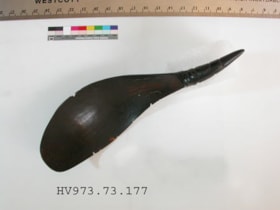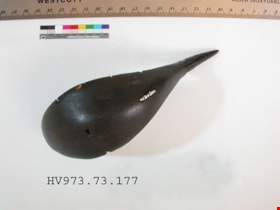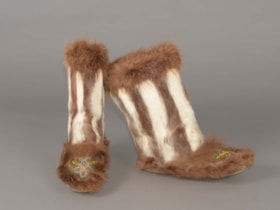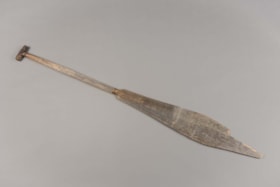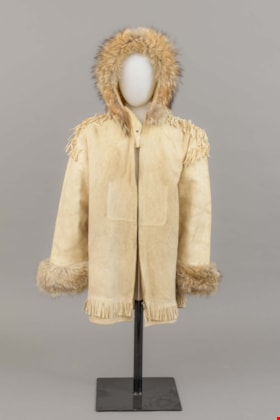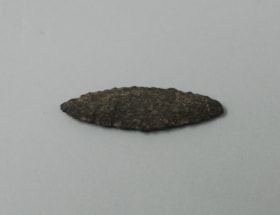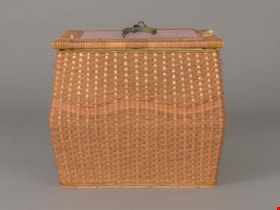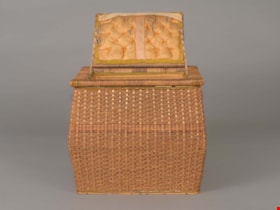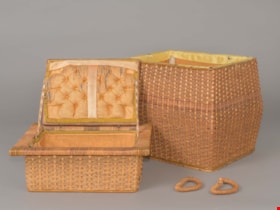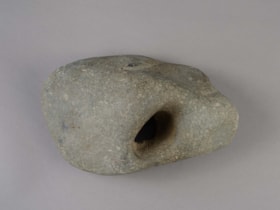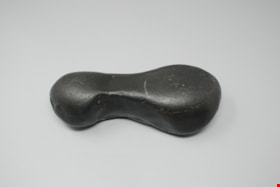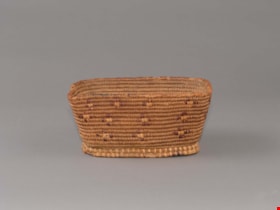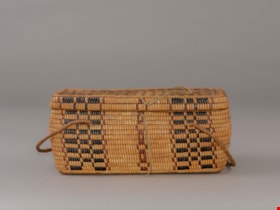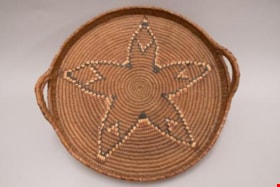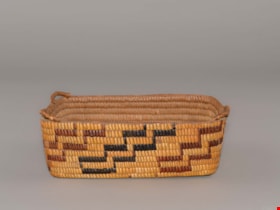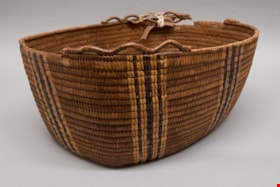Narrow Results By
Creator
- Anders, F. 1
- Anders, Fred 1
- Bennett, D. 1
- British Columbia Hydro and Power Authority 1
- Buccino, Fred 1
- Bullock, V.E. 1
- Burnaby Village Museum 1
- Buzza, Joy 4
- Cabeldu Motors Limited 1
- Canada. Department of Fisheries 1
- Canada. Department of Labour Economics and Research Branch 2
- Canada. Department of Mines and Technical Surveys. Geographical Branch 1
Person / Organization
- Aikenhead, May 1
- Air Raid Precautions (A.R.P.) 3
- Bailey, Joan 8
- British Columbia Electric Railway Company 1
- British Columbia Organization to Fight Racism 1
- Burnaby Centennial '71 Committee 3
- Burnaby Cougars 1
- Burnaby Village Museum 58
- Canadian Farmworkers Union 1
- Century Park Museum Association 29
- Chouhan, Raj 1
- Copan, Donald Angus "Don" 1
Mountain Goat Horn Spoon
https://search.heritageburnaby.ca/link/museumartifact30018
- Repository
- Burnaby Village Museum
- Accession Code
- HV973.73.177
- Description
- Horn spoon with fine carving on the narrow handle. Material is very dark.
- Object History
- Along the Northwest Coast, in general, undecorated spoons of wood and horn were used in everyday life, while more elaborately carved versions were used on special occasions. Horn spoons were often passed down in families as heirlooms, such spoons are generally darker in colour than those of recent manufacture. The bowls of these spoons are too large to place in the mouth, so food is sipped from the sides or the end.
- The bowl of the mountain goat horn spoon is made from the larger part of the horn, at the base. The handle is made from the tip. It is straightened out by steaming in a wooden mould and then scored out inside as part of the shaping process
- Country Made
- Canada
- Province Made
- British Columbia
- School/Style
- Coast Salish
- Culture
- Haida
Images
Documents
mukluks
https://search.heritageburnaby.ca/link/museumartifact84434
- Repository
- Burnaby Village Museum
- Accession Code
- BV008.54.2
- Description
- Pair of mukluks made out of a combination of muskrat, caribou, seal, and moose hide. The musktrat fur goes up the calf of the muklucks. There is bead work on the upper foot and toe area, using yellow, green, blue, red, pink and black beads to make a floral design.
- Object History
- Parka was purchased by donor's wife in either Altin BC or near Perry River, Yukon between 1936 and 1943.
- Country Made
- Canada
- Province Made
- British Columbia
- Site/City Made
- Atlin
Images
Documents
paddle
https://search.heritageburnaby.ca/link/museumartifact16839
- Repository
- Burnaby Village Museum
- Accession Code
- HV980.2.131
- Description
- Men’s paddle carved from cedar wood. The shaft is flattened with a "T" style grip mortised at top The blade is flat with one side of the tip missing. There are other cracks in the blade.
- Object History
- Style of blade indicates it is a man’s paddle, for everyday use (see Barnett 1955:116). Anthropologist Homer Barnett notes: “Paddles were made of yellow cedar, yew, and maple. Those of maple and cedar were painted, the man’s being black and the woman’s red. A smoky pitch fire and oil gave an impenetrable black (116). Men’s paddles had a crutch or crosspiece handle – either one piece or doweled on. There were different shapes of paddles for women, steering, sealing and night hunting.
- Marks/Labels
- "Yale" written on tag.
- Country Made
- Canada
- Province Made
- British Columbia
- Site/City Made
- Yale
- School/Style
- Coast Salish
Images
Documents
parka
https://search.heritageburnaby.ca/link/museumartifact84433
- Repository
- Burnaby Village Museum
- Accession Code
- BV008.54.1
- Description
- Possible caribou hide parka with fur trimmed hood and cuffs. There are tassels along the shoulders and bottom hem. There is a zipper closure at the front.
- Object History
- Parka was purchased by donor's wife in either Altin BC or near Perry River, Yukon between 1936 and 1943.
- Country Made
- Canada
- Province Made
- British Columbia
- Site/City Made
- Atlin
Images
Documents
projectile point
https://search.heritageburnaby.ca/link/museumartifact46054
- Repository
- Burnaby Village Museum
- Accession Code
- BV003.77.1
- Description
- Projectile point, made from black stone with rust specks, possibly from iron oxidization. Oval-shaped, with two pointed ends. One tip end is broken off.
- Object History
- Identified as Cascade culture phase associated with side-notched points from Columbia Plateau dating to 4500-2000 BC, spreading west by 1800 BC (onset of Marpole Culture on Coast).
Images
Documents
sewing basket
https://search.heritageburnaby.ca/link/museumartifact85410
- Repository
- Burnaby Village Museum
- Accession Code
- X3835
- Description
- Sewing basket attributed to First Nations possibly Tsawassen. The basket has a woven design with an inset lid that acts as additional storage that is suspended above the main compartment of the basket.
Images
Documents
stone anchor
https://search.heritageburnaby.ca/link/museumartifact15961
- Repository
- Burnaby Village Museum
- Accession Code
- HV983.60.1
- Description
- Smooth gray stone with a irregularly shaped hole on the narrower end of the stone.
- Object History
- Anchor used to secure a house post, or post supporting a wall. Large stone with hole through center,
Images
Documents
stone anchor
https://search.heritageburnaby.ca/link/museumartifact81702
- Repository
- Burnaby Village Museum
- Accession Code
- BV011.15.1
- Description
- A double lobbed stone of a basaltic, black rock. It could be a pounder although it is too rough to have seen use as a grinding stone. With its two lobs it may have been an anchor stone.
- Marks/Labels
- No recognized marks
Images
Documents
storage basket
https://search.heritageburnaby.ca/link/museumartifact12639
- Repository
- Burnaby Village Museum
- Accession Code
- BV985.4184.1
- Description
- Tub shaped coiled cedar root basket with cedar root foundation and overcast rim. Walls of basket flare slightly towards rim. Imbricated with designs in red cherry bark and grass. Design is known as cluster of flies. The foot on the bottom of the basket, made from two extra rows of coiling, is a feature that protects the base of the basket from wear and tear. White beading on the foot. Interior Salish: Nlaka’pamux: Spuzzum possibly
- Object History
- White beading on the foot of the basket is said to be a feature typical of Spuzzum. This was reported by basket makers from that community during collections research conducted at MOA to Sharon Fortney and Bill Mclennan.
- Country Made
- Canada
- Province Made
- British Columbia
- Culture
- Nlaka'pamux
Images
Documents
storage basket
https://search.heritageburnaby.ca/link/museumartifact17680
- Repository
- Burnaby Village Museum
- Accession Code
- HV978.2.12
- Description
- Rectangular coiled cedar root basket with cedar slat foundation. Parallel slat construction for lid, which is covered in beaded designs. Overcast handles attach to the front and back of basket at both ends. Conoid lid fits overtop of the basket, rather than lying flat. Basket body is completely imbricated with canary grass, black-dyed and red cherry bark. This amount of decoration more common on older pieces and was used to protect the surface of the basket. Leather hinges attach lid to body of basket and there are leather ties at front on lid and body of basket. Possible ladder design. Interior Salish: Nlaka’pamux
- Country Made
- Canada
- Province Made
- British Columbia
- Culture
- Nlaka'pamux
Images
Documents
tray
https://search.heritageburnaby.ca/link/museumartifact87627
- Repository
- Burnaby Village Museum
- Accession Code
- BV017.12.1
- Description
- tray; a First Nations made, basketry tray; low sides and two raised handles opposite each other; decorative star or flower pattern woven into the bottom in varying shades of brown; multiple areas of loss around outer sides of rim.
- Object History
- The tray and two baskets (see BV017.11.3 and BV017.11.4) were acquired by the donor's grandparents, Matilda and Robert William Handel, when they were living in North Vancouver. They were made by one of the local First Nations weavers, name unknown.
- Measurements
- Approx. Dia.: 43 cm
Images
Documents
work basket
https://search.heritageburnaby.ca/link/museumartifact27528
- Repository
- Burnaby Village Museum
- Accession Code
- HV974.119.2
- Description
- Rectangular coiled cedar root basket with cedar slat foundation and remnants of a loopwork rim. The shiny appearance of this grass suggests it is canary grass. Black dyed and red cherry bark are used for the zigzag designs. Coast Salish: Sḵwx̱wú7mesh?
- Object History
- The donor reported that the baskets were traded in the early 1920s for clothes by the donor's mother, who lived in North Vancouver. Her mother told her the "Capilano Indians" used to go door to door with their baskets in North Vancouver.
- Zig zags are sometimes referred to as lightening or snake tracks.
- Country Made
- Canada
- Province Made
- British Columbia
- Culture
- Sḵwx̱wú7mesh
Images
Documents
work basket
https://search.heritageburnaby.ca/link/museumartifact80211
- Repository
- Burnaby Village Museum
- Accession Code
- BV009.1.2
- Description
- Oval shaped coiled cedar root basket with cedar slat foundation. Overcast rim with remnants of a loopwork border. Decorated with vertical stripes of imbricated designs in canary grass and black dyed cherry bark. Cherry bark can be distinguished by the small eyes in the surface of the bark. If the basket maker is skilled the bark has a shiny appearance, if it has not been scraped properly it has a greyish tinge. Canary grass is differentiated from cattail and bear grass by its shiny appearance according to a Stó:lō/Stl’atl’imx elder and basket maker from Mount Currie, who was married into Upper Sḵwx̱wú7mesh.
- Object History
- Basket, ca. 1895-1910, from the collection of the L. Claude Hill family, who owned the property that became the Burnaby Village Museum. According to the Hill family, L. Claude's wife Anne Sarah Hill (nee Kendrick) traded blankets for baskets, although it is not known if this particular basket was obtained in this manner. Indigenous people travelled the trail that crossed Deer Lake Brook (Douglas Road / Canada Way).
- Measurements
- Measurements: width 31.5 cm and length 51.5 cm and depth 19.5 cm all measured from top edge to outside of basket, not including trim.
- Country Made
- Canada
- Province Made
- British Columbia
- School/Style
- Coast Salish
- Culture
- First Nations
